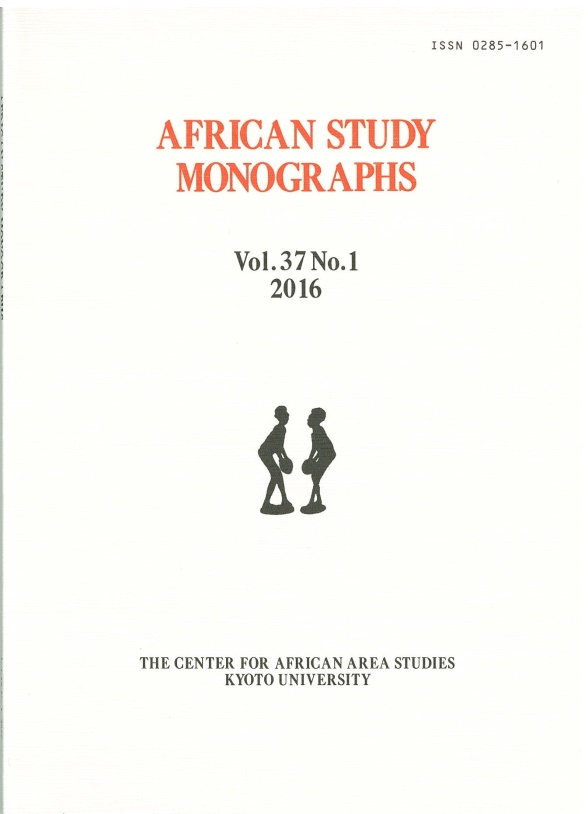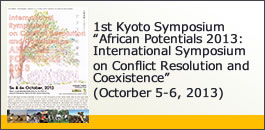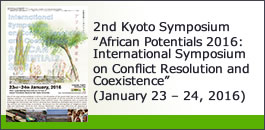[7th Public Workshop / 6th Meeting of Culture and Society Research Unit] "Chiefdom in Africa: An institution of the past or for the future?"Petr Skalník (University of Hradec Kralove, Czech Republic) (Co- organized by the 7th Kyoto University African Studies Seminar (KUASS), October 9, 2012)
Date: Tue., Oct. 09, 2012 15:00-17:30
Venue: Inamori Memorial Foundation, Kyoto University
Chiefdom in Africa: An institution of the past or for the future?
Petr Skalník (University of Hradec Kralove, Czech Republic)
Abstract
Chiefdoms have been in many ways transformed during the colonial and post-colonial times but they still exist in many parts of Africa, Oceania, the Americas and even in Asia. In Europe and non-native America various institutions such as political parties, trade unions, sports clubs and corporations function in ways that resemble chiefdoms. Chieftaincy in Africa is partly discredited and partly revered as a moral authority. In Ghana people and ethnic groups, especially those labeled “acephalous” vie for attaining chiefly status. “Chieftaincy quarrels” lead to armed clashes, unrest and loss of identity. At the same time the modern state in Africa is mostly corrupt, structurally weak or violent towards its own citizens. Chiefs still enjoy high moral status or strive to regain it. At the moment one witnesses revival of chiefdoms’ role as central institution of African society. The solution to the dilemmatic situation might be to “tame” the imported state by according to the chiefs the role of watchdog of democracy. I call it the New Indirect Rule, based on equality of state and chiefdom principles. Is it a wishful thinking or a viable project? What can we learn from Africa?
[First Seminar on Conflict and Coexistence in Africa] (July 30, 2012)
Date: July 14, 2012. 11:15-14:45
Venue: Inamori Foundation Memorial Bldg, Small-sized Meeting Room, Kyoto University
Program
11:15-11:45: Tetsuya Ohno (Toin Yokohama University)
Conflicting Forms of Legitimacy: The Protest against the Kakamega Forest National Reserve in Kenya
11:45-12:15: Hidyeuki Okano (JSPS/ Osaka University)
How Armed Conflicts Expand to Neighbors: Alliances of Armed Factions beyond the Border between Liberia and Sierra Leone
12:15-12:45 Tea Break
12:45-13:15: Futoshi Kato (Japan Society for the Promotion of Science)
Avoidance of Land-use Conflicts and Development of a Cooperative Relationship between Farmers and Agro-pastoralists in a Floodplain: A Case Study of the Kilombero Valley, Tanzania
13:15-13:45: Mihoko Nakazawa (Kobe University)
Living Environments of Orphans and their Impact on Education in Tanzania
13:45-14:15: Sota Harako (Kyoto University)
Integrating and Separating Settlements and Sharing Forest Resources in Shifting Cultivation: A Case Study of a Mountain Village in Southeastern Tanzania.
14:15-14:45: Meyu Yamamoto (Kyoto University)
Reconstruction of Racial Categories in Post-Apartheid South Africa: Chinese Communities in South Africa during the Past Century
Summary
Conflicting Forms of Legitimacy: The Protest against the Kakamega Forest National Reserve in Kenya
Tetsuya Ohno (Toin Yokohama University)
Many regions in the contemporary world are struggling to revitalise local communities. In this context, some communities with unique cultural or natural resources have been pursuing this goal by registering as National Reserves. Indeed, many governments are seeking to register with the National Reserve to turn their unique cultural and natural resources into tourist attractions.
However, the National Reserve has another important purpose: “Development through protection.” This differs substantially from the policy of “either protection or development”, which has been maintained by many governments. The role of National Reserve sites as tourist attractions makes it possible to pursue development without destroying significant cultural or natural resources.
Although the Kakamega Forest in the western province of Kenya has been registered as a National Reserve site, some people still strongly oppose this status. Why are they objecting?
Taking this question as a starting point, this presentation introduces the logic behind their objections while exploring another possibility for community revitalisation based on arguments drawn from the field of anthropology.
How Armed Conflicts Expand to Neighbors: Alliances of Armed Factions beyond the Border between Liberia and Sierra Leone
Hidyeuki Okano (JSPS/ Osaka University)
Since the initiation of the first Liberian civil war (1989), both Liberia and its neighbouring countries (Sierra Leone and Cote d’Ivoire) have experienced armed conflicts. At present (as of June 2012), armed groups remain active in the border areas between Liberia and Cote d’Ivoire, and are both cause and effect of the continued insecurity associated with the expansion of armed conflict into neighbouring countries. Indeed, even though one conflict may end, others continue. I have collected life histories of combatants and commanders in Liberia and Sierra Leone to clarify how armed conflicts expand to neighbouring countries.
During the conflict in Sierra Leone (1991–2002), local leaders created community-level vigilantes. One vigilante group, the Kamajors, was established by the Mende people. However, the Kamajors were mobilised by the regime of Ahmed Tejan Kabbah (1996–1997/1998–2007) as a pro-governmental force. When the Kabbah regime was overthrown by a coup, the Kamajors started to fight against the junta (Armed Forces Revolutionary Council, AFRC). This presentation examines themovement of Kamajors from the overthrow of the Kabbah regime (May, 1997) to his reinstatement (March, 1998).
During this period, the behaviour of Kamajors epitomised the cross-border influence of armed conflicts. Indeed, they received reinforcement from stations at the Sierra Leone–Liberia border, and key persons associated with both Liberia and Sierra Leone have used their human networks to help the Kamajors. By examining the Kamajor movement and its use of transnational human networks consisting of several key persons, I clarify how one conflict can be influenced by a conflict in an adjacent country.
Avoidance of Land-use Conflicts and Development of a Cooperative Relationship between Farmers and Agro-pastoralists in a Floodplain: A Case Study of the Kilombero Valley, Tanzania
Futoshi Kato (Japan Society for the Promotion of Science)
Paddy fields and grazing lands are increasing in swamps in Sub-Saharan Africa as a result of land development. The Kilombero Valley, an inland flood plain located in the southern part of Tanzania, covers an area of about 11,600 km2. Land development was promoted in this valley, and it became a major rice production area, accounting for about 10% of all the rice produced in Tanzania. Furthermore, the Kilombero Valley became a major cattle production area after the migration of the Sukuma agro-pastoralists to the valley.
Land competition in this area caused conflict between agriculturalists and agro-pastoralists, which led to riots. However, the relationship between agriculturalists and agro-pastoralists became cooperative in the context of a system of mutual help, which was implemented in the agricultural sector as a result of mediation performed by elders in the community. As part of the reconciliation process, agro-pastoralists used oxen to plow the paddy fields of the agriculturalists, while agriculturalists allowed the agro-pastoralists’ cattle to graze in the village. The council of elders encouraged this process. In the Kilombero Valley, cultural values (e.g., respect for elders), technology (e.g., ox-plowing techniques), and resources (e.g., animal power and foraging) contributed to reconciliation between agriculturalists and agro-pastoralists.
Living Environments of Orphans and their Impact on Education in Tanzania
Mihoko Nakazawa (Graduate School of International Cooperation Studies, Kobe University)
The HIV/AIDS pandemic has caused a rapid increase in the number of orphans and other types of vulnerable children in Tanzania. It has been reported that 10% of children in mainland Tanzania are orphans who have lost at least one parent (TACAIDS, 2008). In many cases, orphans are socioeconomically more vulnerable and disadvantaged than are children with both parents, especially in terms of educational opportunities.
Nevertheless, it is also believed that family networks have mitigated the detrimental impacts of orphanhood. Child fostering had been widely practiced among relatives in Tanzania even before HIV/AIDS pandemic. Previous studies have cited such family networks as the reason for the slight difference between the rates of primary school enrollment among orphans and non-orphans.
In this study, based on field research conducted from December 2011 to March 2012, we explored the potential of Tanzanian society to advance opportunities for coexistence by clarifying the mechanisms underpinning the social inclusion of orphans and elucidating how this affects their education.
Integrating and Separating Settlements and Sharing Forest Resources in Shifting Cultivation: A Case Study of a Mountain Village in Southeastern Tanzania.
Sota Harako (Kyoto University)
Implementation of the policy of villagisation in Tanzania during the 1970s led to the incorporation of small scattered villages into Ujamaa village. Although the Tanzanian government had created a civil infrastructure and social services in the village, these institutions were beset by financial difficulties soon after they were established. In 1986, the government implemented economic deregulation, promoted decentralisation, and enacted policies designed to reduce poverty after 2000.
In Ifinga Village, located in the southeastern part of the Eastern Arc Mountains, scattered settlements engaged in shifting cultivation were integrated into a single village consisting of various clans and tribes. Their lifestyle changed from one in which they moved their field and house every 2 years to one in which they remained in Ujamaa Village to cultivate the land. In 1972, before villagisation, the bamboo growing wild near Ujamaa Village flowered prodigiously, and the seeds of these plants were broadcast. Cultivation of these seeds produced the vast bamboo forest near Ujamaa Village. Due to the difficulty of clearing fields in bamboo forests, most farmers left the bamboo forest and moved to a forest consisting of trees. Starting in 2000, reliance on a market economy became widespread in this village as a result of road maintenance. Famers built their houses in Ujamaa Village to ensure access to social services and the market economy while also cultivating the tree forest, which became more peripheral, and narrower, due to the expansion of the bamboo forest. Settlements constructed in fields in which shifting cultivation was performed consisted of individuals who had to move every time they shifted fields. This practice facilitated the sharing of land resources and eased tensions among people.
Reconstruction of Racial Categories in Post-Apartheid South Africa: Chinese Communities in South Africa during the Past Century
Meyu Yamamoto (Kyoto University)
Despite their small numbers, Chinese residents is indispensable to an exploring and understanding of South African racial policies. Indeed, the first industrial colour barriers were erected specifically to exclude Chinese individuals from skilled occupations. Today, racial conflict about the historical treatment of Chinese individuals under the apartheid government persists. This presentation underscores the contribution of studying the treatment of Chinese residents to an understanding of racism and racial policies in South Africa during the past century. It will address the following topics: 1) the history of the treatment of Chinese residents since the late 19th century, and 2) the 2008 ruling by the Pretoria high court that the Chinese community be included in the definition of “black people” for purposes of economic empowerment.
[5th Public Workshop / 1st Meeting of West Africa Research Cluster] (February 15, 2012)
Date: February 15, 2012
Venue: Inamori Foundation Memorial Bldg. (Inamori Center), Middle-sized Meeting Room, Kyoto University
Program
“Nigeria: The Post-Amnesty Blues and the Future of Insurgency in the Niger Delta”
Dr. Abdul Raufu Mustapha (Oxford University)
“Boko Haram: The Long Road to Islamic Terrorism”
Dr. Charles Ukeje(Obáfẹmi Awólọwọ University)
Abstract
“Nigeria: The Post-Amnesty Blues and the Future of Insurgency in the Niger Delta”
Dr. Charles Ukeje(Obáfẹmi Awólọwọ University)
Despite its huge hydrocarbon resources, popular struggle to draw attention to the myriad developmental challenges facing the oil region of Nigeria entered a ferocious and vicious phase from the mid-1990s with the emergence of a plethora of armed groups with access to sophisticated weapons and the capability to cripple oil production and undermine national security. These groups launched daring attacks on oil installations, kidnapped oil worker (and also notable individuals), and vandalised oil infrastructure. By 2008-2009, their exploits had crippled oil production to about one-thirds of the country’s daily output of 2.4million barrels.
This was the backdrop against which the Yar’Adua administration, only two years in the saddle, announced presidential amnesty to those involved in perpetrating the heinous crimes if they surrendered their weapons and denounced violence within the 60-day grace period stipulated, starting from June 25, 2009. The government also promised to put the ex-militants, as they are popularly known, into rehabilitation and vocational training schemes that would enhance their seemless re-integration into productive community life.
More than two years after the Amnesty Proclamation, there is enough objective basis to evaluate the post-amnesty achievements and shortcomings, if any, along with the prospects for the future. What, for instance, has happened to the ex-militants in the post-amnesty period? What structures of incentive have been put in place by the government to drive what is widely touted to be an ambitious, even grandiose, idea? And, to what extent have the ex-militants taken advantage of the post-amnesty opportunities? Whereas the post-amnesty phase drastically reduced the spate and intensity of insurgent attacks, to what extent can it pave the way for durable peace and sustainable development in the Niger Delta? Is the amnesty, in fact, not another contrived short-cut to peace in Nigeria’s Delta? What is the role of critical stakeholders, including spoilers, vis-a-vis the implementation of the post-amnesty priorities? Finally, what are the alternative futures for the State, oil companies and local communities in the post-amnesty era; especially against the background of recent developments in the still largely impoverished and volatile oil region?
“Boko Haram: The long road to Islamic Terrorism”
Dr. Abdul Raufu Mustapha (Oxford University)
Since 2009, Nigeria has been rocked by a wave of Islamist insurgency, ostensibly led by the Boko Haram group. According to Human Rights Watch, over 260 people were killed in numerous attacks in January 2012 alone. Predictably, numerous arguments and theories have been advanced to explain the phenomenon of Boko Haram. From conspiracy theories to historical reconstructions, we are faced with numerous and conflicting explanations of a phenomenon that continues to extract a toll in lives and limbs. In this presentation, I address three key questions: Who are Boko Haram? What do they want? How best can Nigeria and the international community address the challenge posed by the organization?
[3rd Public Workshop / 3rd Meeting of Culture and Society Research Unit] (October 21, 2011)
Date:21 Oct, 2011 15:00-18:00
Venue: Small Seminar Room, 3F Inamori Bldg.,
Kawabata Campus http://www.asafas.kyoto-u.ac.jp/en/about/access.html
Program
15:00-15:10 Introduction
15:10-16:30 John Galaty (McGill University)
“Maasai Land Conflicts and Civil Society: Local Struggles and a Global Audience”
16:30-16:40 Coffee break
16:40-18:00 Junko Maruyama (Tsuda College)
“Resettlement, Development and Indigenous Peoples’ Movement: Two Cases from San Communities in Southern Africa”
Abstract
John Galaty (McGill University)
“Maasai Land Conflicts and Civil Society: Local Struggles and a Global Audience”
The ascendency of the state in Africa and the process of privatizing agrarian land has made many rangeland communities vulnerable to having their mobility drastically curtailed and even to losing their land. This paper will examine the opportunistic seizure of pastoral lands by a variety of actors, including smallholder farmers, political class, entrepreneurs, commercial farmers, speculators, conservationists, tour operators, miners, and foreign states, from the colonial period to the present. From small- to large-scale, valuable pastoral lands have been or are being acquired through local incursions, state allocation or purchase, promising to use it for highly efficient commercial agriculture, or by conservation groups and entrepreneurs who vow to protect wildlife and at the same time propagate high-end lucrative tourist ventures. Land displacements have come to represent a major cause of violent conflicts and legal disputes in pastoral regions. In recent decades, organizations of civil society have increasingly sprung up to defend pastoral land rights, often linking their causes to claims of indigeneity anchored in the creation of the Permanent Forum on Indigenous Issues. The global audience for indigenous land loss and the advocacy of national and international civil society has both mitigated and stimulated local conflicts. Paradoxically, as indigenous land rights have been recognized, actual land loss has accelerated due to the increasingly aggressive role of the state in large-scale land acquisitions by outside parties. This paper will examine the interaction between land grabbing, land losses, and land conflicts, and role played by civil society and assertions of indigenous rights in Eastern and Southern Africa, with special focus on the experience of the Maasai of Kenya and Tanzania.
Junko Maruyama (Tsuda College)
“Resettlement, Development and Indigenous Peoples’ Movement: Two Cases from San Communities in Southern Africa”
The notion that indigenous peoples should have the right to maintain their distinct cultures, lifestyles, and territories has become widely accepted within the international community during the last two decades. While the concept “indigenous peoples” is highly controversial in African context compared with the more consensual situation in nations with white settlers, the San hunter gatherers of Southern Africa also have been involved in global indigenous peoples’ movement, and become one of the best-known “indigenous peoples” in Africa. Indeed, recently some groups of the San have successfully acquired land rights, with the support of the global movement. Of these, two cases from Botswana and South Africa will be highlighted in this presentation; Botswana San won in court the right to return to their land in nature conservation area, and the San in South Africa were handed over land title deeds from President Mandela. Both cases were hailed by NGOs, activists, and the mass media as a landmark for the rights of indigenous peoples in Africa. This presentation will analyze the historical backgrounds and the negotiation process of these two cases, and then elucidate the San’s livelihood and social relationships after they gained land-use rights. Finally, by comparing both cases, dynamics underlying relationships between the San and national and international communities, and positive and negative impacts of the global indigenous peoples’ movement on the San will be discussed.


 Exploring African Potentials, Mila Special Issue
Exploring African Potentials, Mila Special Issue
